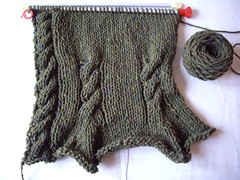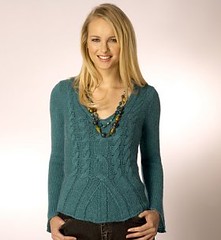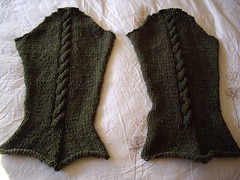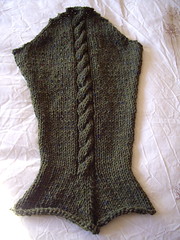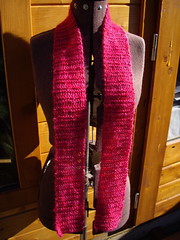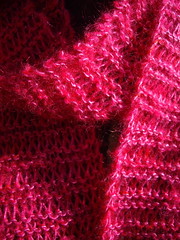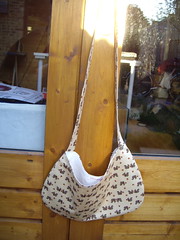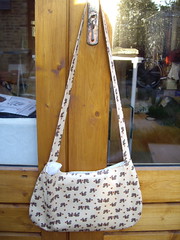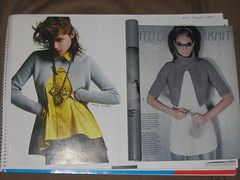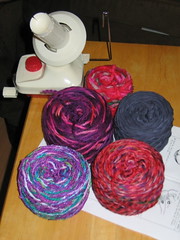Recently I bought a sewing pattern from an American Ebay seller. As a little free gift, she included a mini packet of Kool Aid! Having looked at the ingredients and decided that I didn’t want to risk actually drinking it, I thought it might be fun to do a little experiment.
I must admit, I didn’t have very high hopes for this experiment’s success. The instructions on Knitty and in Simply Knitting Magazine (Issue 26, April 2007) both state that you should use only unsweeetened Kool Aid, and that you should allow 1-2 3.9g packets per 50g of wool. I had only one individual serving (smaller – sorry, I didn’t note down the weight) packet of sweetened Kool Aid, so I wasn’t at all sure whether it would have any effect on the wool at all.
I bought a single 50g ball of Sirdar Eco Wool. It’s completely undyed, so I figured that would be perfect. I followed the instructions in Simply Knitting magazine.
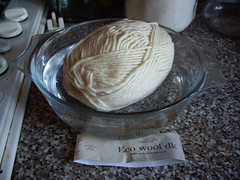
First I pre-soaked the ball of wool in warm water. Apparently wool floats! Not to worry – it soon sinks when it gets nice and wet. It helps to press the air out a bit.
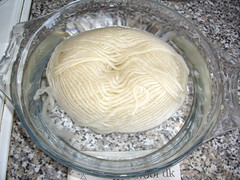
I left the ball of wool soaking for about an hour, to let it get nice and wet all the way through. I didn’t bother unwinding the ball into a skein, as I figured that the dye bath would penetrate all the way through, and I didn’t mind if the outside was brighter then the inside. I just wanted to see whether it would work at all! The water is warm, but not too warm.
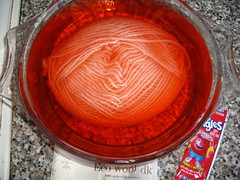
Here’s the wool, now soaking in the Kool Aid.
I took the ball of wool out of the water, and drained it in a colander. I pressed out most of the water, taking care not to scrunch the wool about too much, in case of felting. In the casserole dish, I poured in the Kool Aid, and then diluted it with warm water, roughly the same temperature as the wet ball of wool. When all of the Kool Aid crystals were dissolved, I popped the ball of wool into the solution, and added more water – enough to cover the whole ball. I then scrunched the wool around carefully, to make sure the dye was going all the way through.
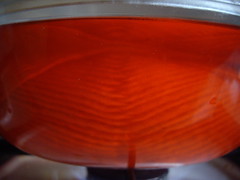
Then it was on with the lid, and onto the hob for a good cooking! Simply Knitting magazine said, “When cooking on the hob, cover and simmer gently for 20-30 minutes”. I left mine cooking for about an hour, because I was watching Funny Girl on tv, and lost track of the time. I don’t think it ever quite reached a simmer either, as I left it on the very lowest setting. During the ad breaks, I carefully turned the ball of wool, to make sure the dye really was going all the way through. I’d recommend using gloves for this part – firstly because it’s hot, and secondly because I ended up with pink fingers for most of the day.

Tipping out the Kool Aid solution, I left the ball of wool until it was cool enough to pick up.
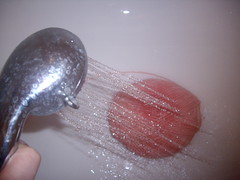
I then transferred it to the shower. I made sure that the water was roughly the same temperature as the ball of wool, and rinsed out the excess dye. I then squeezed out as much water as possible, taking care not to risk accidental felting.

Winding the wool around my clothes airer to dry, I’m really pleased to find that the dye is much more even than I’d hoped for. I think I’d call this experiment a success!

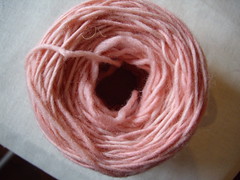
And here’s the final result! Left overnight to dry, and wound into a neat little cake, I have a lovely ball of pale pink wool!
The dyeing made no mess whatsoever (except for my pink fingers, but that was my own silly fault!), took very little supervision, and was extremely easy to do.
You can buy Kool Aid in the UK from D T Crafts or Kool Aid UK for as little as 40-50p per packet. Kool Aid UK also sometimes sell expired packets specifically for dyeing, as they can’t be used for drinking once they’re out of date.
The ball of Sirdar Eco Wool cost £3.99, so the addition of 50p for the dye definitely wouldn’t break the bank. I’m not sure I’d want to try and dye the yarn for a whole jumper, as you’d have to get a bit scientific about the dilution of the Kool Aid to make sure that all of the wool came out pretty much the same colour. But for single-ball projects, I’m definitely going to be doing this again!

